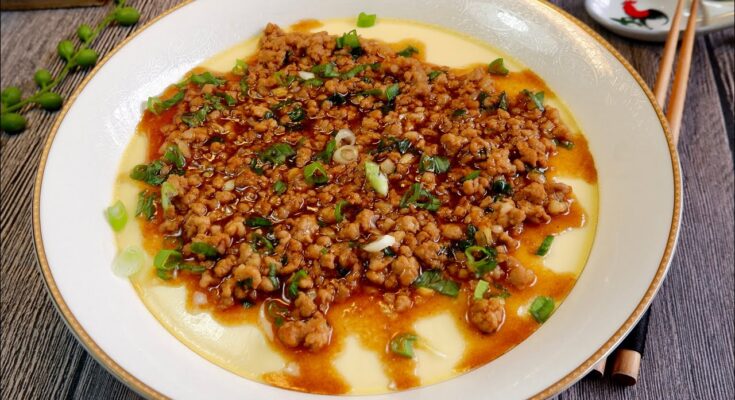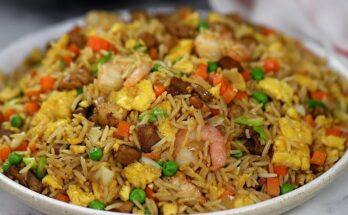Chinese Steamed Egg Recipe: Ever tasted a dish so soft and smooth it melts in your mouth like silk? That’s the magic of Chinese steamed egg, also known as “水蒸蛋” (shuǐ zhēng dàn). It’s humble yet comforting, and honestly, it’s one of the easiest dishes you can master in Chinese home cooking.
Whether you’re craving something light for breakfast, a side for dinner, or a soothing bite when you’re under the weather—this dish always hits the spot. Let’s dive into how you can make this creamy, custardy wonder right at home!
What is Chinese Steamed Egg?
Chinese steamed egg is a traditional, savory custard made by gently steaming a mix of beaten eggs and water (or broth). The result? A silky-smooth, pudding-like texture that’s incredibly satisfying. Unlike Western custards, this dish is not sweet. It leans on simplicity and umami, often seasoned with light soy sauce, sesame oil, and occasionally topped with scallions or dried shrimp. You’ll commonly find it served at family dinners, especially for kids and the elderly due to its soft texture and easy digestibility.
It’s a dish that reflects the core philosophy of Chinese cooking—balance, simplicity, and nourishment. And yes, even though it only uses a few basic ingredients, perfecting its texture takes a bit of finesse. But don’t worry—we’ve got you covered with every step in detail.
Why You’ll Love This Dish
Here’s why Chinese steamed egg deserves a permanent spot in your recipe rotation:
- Ridiculously Simple: Just eggs, water, and a pinch of salt.
- Versatile: Customize it with toppings like scallions, soy sauce, or minced pork.
- Healthy and Light: High in protein, low in fat, and easy to digest.
- Budget-Friendly: No fancy ingredients needed.
- Fast: You can whip this up in under 20 minutes!
So whether you’re a beginner or a seasoned cook, this dish is your new best friend in the kitchen.
List of Ingredients You’ll Need
Getting started is easy when your ingredient list is short and sweet.
Basic Ingredients
- Eggs – 3 large
- Water or Broth – 1.5 times the volume of the eggs (we’ll explain how to measure this precisely)
- Salt – ¼ teaspoon
- Light soy sauce – for drizzling
- Sesame oil – optional, for added fragrance
Optional Toppings
- Chopped scallions
- Fried shallots
- Minced pork or shrimp
- Century egg
- Preserved vegetables
- Chili oil (for the brave)
Equipment Needed
- Heat-proof bowl (ceramic or glass)
- Steamer or steaming setup (pot with lid and steaming rack)
- Fine mesh strainer
- Measuring cup (or small bowl for volume)
- Chopsticks or whisk
Make sure everything is ready before you start. The process is quick, and timing is everything when it comes to steaming.
How to Choose the Right Eggs
Quality eggs make all the difference in a dish that’s this simple. Look for:
- Freshness: Fresher eggs hold their shape better and offer a smoother texture.
- Color: Egg yolk color can vary by brand and feed, but opt for organic or pasture-raised eggs for better flavor.
- Size: Medium to large eggs work best. Try to use eggs of the same size for consistent cooking.
Crack your eggs into a bowl and give them a gentle sniff—if they’re even slightly off, toss them. This dish is all about clean, pure flavor.
Water-to-Egg Ratio Explained
This is where the magic lies. Mess up the ratio, and your custard might be watery or too firm.
Perfect Ratio: 1 part egg : 1.5 parts water (by volume)
Here’s how to do it:
- Beat your eggs in a measuring cup or pour them into a small bowl.
- Note the volume of the eggs.
- Add 1.5x that amount of warm water or broth.
- Example: If your eggs are 150ml, add 225ml of warm water.
Why warm water? Cold water can cause uneven cooking. Warm water helps the mixture bind better and creates a smoother custard.
Step-by-Step Guide to Making Chinese Steamed Egg
Let’s walk through the entire process so you get perfect results every single time.
Step 1: Crack and Beat the Eggs
Crack 3 eggs into a bowl. Use chopsticks or a fork to gently beat them. The goal here is to combine the whites and yolks evenly without over-whipping. Don’t aim for frothiness; that introduces air bubbles and ruins the smooth texture.
Pro Tip: Stir in one direction only. This helps keep the egg mixture consistent and less foamy.
Step 2: Add Water and Mix
Using the volume method, measure out 1.5 times the amount of warm water (or broth) and slowly pour it into the egg mixture while stirring gently. Add a pinch of salt. Mix until fully combined.
Resist the urge to add too much seasoning at this stage. You’ll finish with soy sauce and oil later.
Step 3: Strain for Smoothness
Place a fine mesh strainer over your steaming bowl and pour the egg mixture through it. This is the game-changer step. Straining removes any unmixed whites or bubbles, giving you that ultra-smooth custard.
If you skip this step, don’t blame the eggs when the texture turns out lumpy!
Step 4: Prepare the Steamer
Set up your steamer. Bring the water to a gentle simmer, not a rolling boil.
Too much heat creates bubbles and holes in the custard.
Place a steaming rack inside a pot, add water, and get it to a simmer while you prep the egg.
Step 5: Pour Mixture into Bowl
Once strained, pour the smooth egg mixture into a shallow bowl or heat-proof dish.
Cover the bowl tightly with plastic wrap or foil. This prevents water droplets from falling onto the surface and ruining that glassy finish.
Alternatively, place a ceramic plate upside-down over the bowl.
Step 6: Steam Properly
Place the bowl into the steamer. Steam over medium-low heat for about 10–12 minutes. Do not use high heat—it’s the enemy of smooth steamed egg.
After 10 minutes, gently shake the bowl. The center should be just set but still jiggly—like soft tofu.
If it’s still too liquid, steam another 2 minutes and check again.
Step 7: Cool and Serve
Once done, remove the bowl and let it cool for 2 minutes.
Add a drizzle of light soy sauce, a few drops of sesame oil, and your choice of toppings—scallions are classic!
Serve immediately while warm. You’ll get a custard so silky it practically quivers with each spoonful.
Tips for Getting That Perfect Silky Texture
If your Chinese steamed egg turns out lumpy, full of holes, or rubbery, don’t worry—it happens to the best of us. The good news? With a few simple adjustments, you can master that silky, glass-like texture every single time.
Here’s what you need to keep in mind:
- Use the correct water-to-egg ratio (1 part egg to 1.5 parts warm water). Get this right first.
- Strain the mixture before steaming. This removes thick egg whites and bubbles, resulting in a smoother surface.
- Avoid vigorous mixing. Beating the eggs too hard introduces air bubbles, which make the texture rough.
- Cover the bowl with foil or a plate while steaming. This prevents condensation from dripping onto the surface.
- Steam on low or medium-low heat. High heat makes the eggs puff up and collapse, causing holes or a rubbery finish.
- Let it rest after steaming. Giving the egg a couple of minutes before serving helps it set and retain moisture.
You’ll know you nailed it when your steamed egg looks like soft tofu or a delicate pudding—gentle, glossy, and spoonable.
Top Mistakes to Avoid
Let’s be honest: cooking something this “simple” means there’s less room to hide mistakes. Here are the most common missteps that ruin Chinese steamed egg, and how to avoid them.
- Overbeating the eggs
- Don’t go wild with the whisk. Gentle is key.
- Wrong water ratio
- Too much water = watery egg. Too little = tough custard.
- Skipping the straining step
- That’s how you end up with stringy egg whites and lumps.
- Using high heat
- Causes bubbles, cracks, and overcooking. Low and slow is better.
- Not covering the bowl
- Water from the steamer lid will drip and dent the surface.
- Opening the lid mid-steam
- You lose heat and steam pressure, causing uneven cooking.
Avoid these, and you’ll be way ahead of most people trying this dish for the first time.
Tasty Topping Ideas to Elevate Your Dish
Sure, plain steamed egg is delicious on its own. But why stop there? Toppings can take it from humble to gourmet in seconds.
Here are some ideas to spice it up:
Classic Toppings
- Chopped scallions – Adds freshness and bite.
- Light soy sauce – Enhances umami.
- Sesame oil – Gives a nutty aroma.
Savory Add-ins
- Minced pork or beef – Cook it first with soy sauce and garlic, then spoon on top.
- Dried shrimp or scallops – Rehydrate and place a few pieces over the custard before steaming.
- Century egg – Slice and place in the middle for a traditional twist.
Creative Toppings
- Fried shallots or garlic chips – Crunchy and flavorful.
- Chili crisp or chili oil – If you like it spicy.
- Mushroom soy or oyster sauce drizzle – Adds depth.
Feel free to experiment and make it your own. This dish is like a blank canvas—simple, yet ready to showcase any flavor you throw at it.
How to Store Leftovers
Let’s say you got a little carried away and made more than you could eat (it happens!). Can you store steamed egg for later?
Absolutely—but carefully.
- Fridge: Place leftover steamed egg in an airtight container and refrigerate for up to 2 days.
- Cover it well: You don’t want it absorbing fridge odors.
- Do not freeze: The texture won’t survive thawing—it’ll turn grainy and watery.
Tip: If you plan to reheat, don’t add toppings until you’re ready to eat. This keeps them fresh and flavorful.
How to Reheat Without Ruining the Texture
Reheating steamed egg can be tricky. Do it wrong, and you end up with a dry sponge. Here’s how to do it right:
Steam it again
- Place the leftover custard in a steamer.
- Steam over low heat for 3–5 minutes until just warm.
- Don’t over-steam—it’s already cooked.
Microwave method (last resort)
- Use low power (30–40%).
- Microwave in 15-second intervals, checking often.
- Cover loosely with a microwave-safe lid to avoid drying out.
Avoid using full power or reheating too long—it’ll destroy that silky texture you worked so hard to create.
Is It Healthy? Nutritional Breakdown
Chinese steamed egg isn’t just tasty—it’s also good for you. Here’s a quick look at what you’re getting in one serving (approximate, based on 3 eggs and basic seasoning):
| Nutrient | Amount |
|---|---|
| Calories | ~210 kcal |
| Protein | ~18g |
| Fat | ~15g |
| Carbohydrates | ~2g |
| Sodium | ~300mg |
| Cholesterol | ~550mg |
Health Benefits
- High in protein – Great for muscle recovery.
- Low-carb – Ideal for low-carb or keto diets.
- Easy to digest – Perfect for kids and the elderly.
- Gluten-free – Just be careful with the soy sauce; use tamari if needed.
Want to make it even healthier? Use egg whites only, skip the oil, and go light on the salt.
Common Variations Across China
Just like many classic dishes, Chinese steamed egg varies from region to region. Here are a few spins on the original:
Cantonese-style
- Often includes dried scallops or shrimp.
- Uses chicken broth instead of water.
Shanghai-style
- Sweeter taste with a dash of Shaoxing wine.
Northern-style
- Topped with minced meat sauce, sometimes spiced.
Taiwanese-style
- Tends to be thicker and often includes mushrooms or tofu cubes.
You can borrow ideas from all over and make your own regional fusion version!
Pairing Suggestions: What Goes Well With Steamed Egg?
This dish is mild and mellow, so it pairs beautifully with stronger, saltier sides. Here are some ideas:
- Congee or rice porridge – Ultimate comfort food combo.
- Steamed rice – Classic and simple.
- Pickled vegetables – Add crunch and acidity.
- Stir-fried greens – Like bok choy or Chinese broccoli.
- Braised tofu or meats – To round out the meal.
Looking for a full dinner spread? Try pairing steamed egg with a soy-braised chicken leg and a bowl of garlicky spinach. Chef’s kiss.
FAQs about Chinese Steamed Egg Recipe
Can I use milk instead of water?
Yes! Milk adds creaminess to the custard. Just replace water with warm milk using the same 1.5:1 ratio.
Why is my steamed egg full of bubbles?
It’s likely from overbeating the eggs or using high heat. Stir gently, strain the mixture, and steam on low to avoid bubbles.
How long does it take to steam?
About 10–12 minutes on medium-low heat. Check for a slight jiggle in the center to know it’s done.
Can I make it in a microwave?
Yes, but it requires care. Use 30–40% power and microwave in short bursts to avoid overcooking.
Is it safe for toddlers or babies?
Absolutely! It’s soft, protein-rich, and easy to digest. Just skip the salt and soy sauce for little ones.
Final Thoughts
Chinese steamed egg is the kind of dish that reminds you just how powerful simplicity can be. With just a few humble ingredients, you can make something comforting, nourishing, and deliciously elegant. Whether you’re craving a soft start to the day or a soothing side for dinner, this silky egg custard is always the right choice.
Once you get the technique down—especially the water ratio and gentle steaming—you’ll find yourself making it over and over again. And trust me, every time you get that perfectly smooth surface, it’ll feel like a small kitchen victory.



